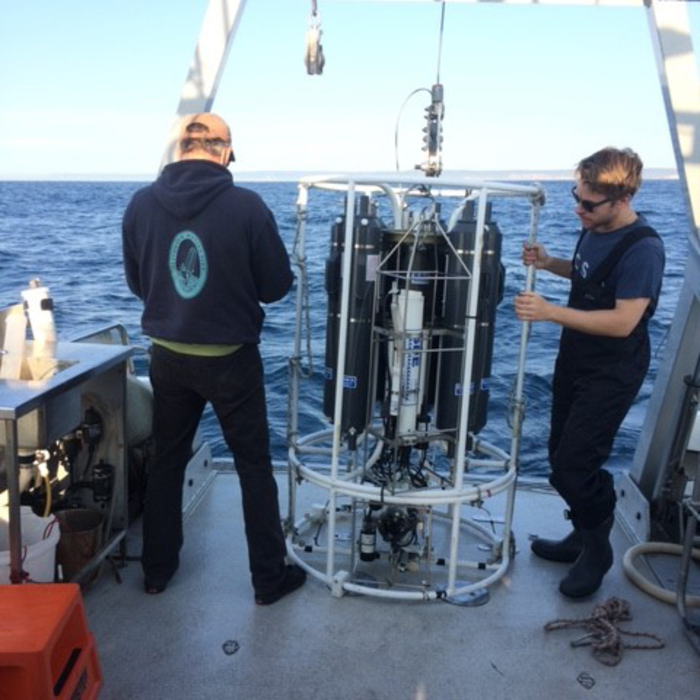A secret weapon in the battle against climate change could be a single-celled marine microbe that is capable of photosynthesis and hunting and eating prey.

Researchers prepare to launch sampling equipment in Port Hacking, eastern Australia. Image Credit: University of Technology Sydney.
At the University of Technology Sydney (UTS), researchers have identified a new species that has the ability to sequester carbon naturally, even as oceans get warm and become highly acidic.
The microbe is found in abundance globally and it photosynthesizes and liberates a carbon-rich exopolymer that tends to attract and immobilize other microbes. It then eats some of the entrapped prey before leaving its exopolymer “mucosphere.” Since the other microbes are trapped by the exopolymer, it becomes bulkier and sinks, thereby becoming a part of the ocean’s natural biological carbon pump.
Dr. Michaela Larsson, a Marine biologist, headed the research and says that the study is the first to illustrate this behavior.
The study was published in the Nature Communications journal.
Marine microbes control oceanic biogeochemistry via a range of processes such as the vertical export and sequestration of carbon, eventually modulating the global climate.
Dr. Larsson states that while the contribution of phytoplankton to the carbon pump is deeply rooted, the roles of other microbes are far less understood and are rarely measured. She states that this is especially true for mixotrophic protists, which can concurrently perform photosynthesis and ingest other organisms.
Most terrestrial plants use nutrients from the soil to grow, but some, like the Venus flytrap, gain additional nutrients by catching and consuming insects. Similarly, marine microbes that photosynthesize, known as phytoplankton, use nutrients dissolved in the surrounding seawater to grow.
Dr. Michaela Larsson, Study Lead Author and Marine Biologist, University of Technology Sydney
Larsson added, “However, our study organism, Prorocentrum cf. balticum, is a mixotroph, so is also able to eat other microbes for a concentrated hit of nutrients, like taking a multivitamin. Having the capacity to acquire nutrients in different ways means this microbe can occupy parts of the ocean devoid of dissolved nutrients and therefore unsuitable for most phytoplankton.”
Prof. Martina Doblin, senior author of the study, states that the findings have global importance for how one observes the ocean balancing the carbon dioxide present in the air.
The scientists evaluate that this species, isolated from waters offshore from Sydney, has the potential to sink 0.02–0.15 gigatons of carbon per year. A 2019 National Academies of Sciences, Engineering and Medicine report has discovered that to fulfill climate goals, CO2 removal technologies and strategies will have to eliminate around 10 gigatons of CO2 from the air annually until 2050.
This is an entirely new species, never before described in this amount of detail. The implication is that there’s potentially more carbon sinking in the ocean than we currently think, and that there is perhaps greater potential for the ocean to capture more carbon naturally through this process, in places that weren’t thought to be potential carbon sequestration locations.
Martina Doblin, Study Senior Author and Professor, University of Technology Sydney
Doblin states that an interesting question is if this process could develop a part of a nature-based solution to improve carbon capture in the ocean.
The natural production of extra-cellular carbon-rich polymers by ocean microbes under nutrient-deficient conditions, which we’ll see under global warming, suggest these microbes could help maintain the biological carbon pump in the future ocean.
Martina Doblin, Study Senior Author and Professor, University of Technology Sydney
Doblin continued, “The next step before assessing the feasibility of large-scale cultivation is to gauge the proportion of the carbon-rich exopolymers resistant to bacteria breakdown and determine the sinking velocity of discarded mucospheres.”
“This could be a game changer in the way we think about carbon and the way it moves in the marine environment,” added Doblin.
The Australian Research Council provided funding for the study through a Discovery grant.
Journal Reference:
Larsson, M. E., et al. (2022) Mucospheres produced by a mixotrophic protist impact ocean carbon cycling. Nature Communications. doi.org/10.1038/s41467-022-28867-8